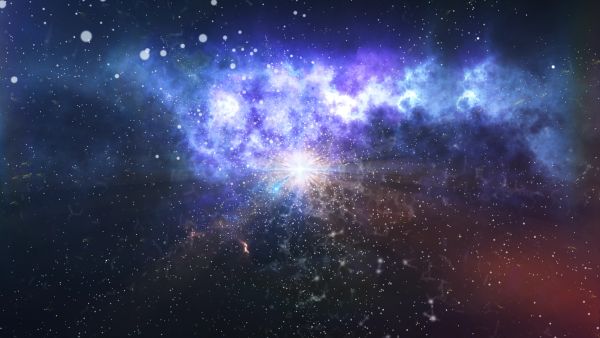We may finally be able to test one of Stephen Hawking's most far-out ideas

We may soon be able to test one of Stephen Hawking's most controversial theories, new research suggests.
In the 1970s, Hawking proposed that dark matter, the invisible substance that makes up most matter in the cosmos, may be made of black holes formed in the earliest moments of the Big Bang.
Now, three astronomers have developed a theory that explains not only the existence of dark matter, but also the appearance of the largest black holes in the universe.
"What I find personally super exciting about this idea is how it elegantly unifies the two really challenging problems that I work on — that of probing the nature of dark matter and the formation and growth of black holes — and resolves them in one fell swoop," study co-author Priyamvada Natarajan, an astrophysicist at Yale University, said in a statement. What's more, several new instruments — including the James Webb Space Telescope that just launched — could produce data needed to finally assess Hawking's famous notion.
Related: Stephen Hawking's most far-out ideas about black holes
Black holes from the beginning
Dark matter makes up over 80% of all the matter in the universe, but it doesn't directly interact with light in any way. It just floats around being massive, affecting the gravity within galaxies.
It's tempting to think that black holes might be responsible for this elusive stuff. After all, black holes are famously dark, so filling a galaxy with black holes could theoretically explain all the observations of dark matter.
Breaking space news, the latest updates on rocket launches, skywatching events and more!
Unfortunately, in the modern universe, black holes form only after massive stars die, then collapse under the weight of their own gravity. So making black holes requires many stars — which requires a bunch of normal matter. Scientists know how much normal matter is in the universe from calculations of the early universe, where the first hydrogen and helium formed. And there simply isn't enough normal matter to make all the dark matter astronomers have observed.
Sleeping giants
That's where Hawking came in. In 1971, he suggested that black holes formed in the chaotic environment of the earliest moments of the Big Bang. There, pockets of matter could spontaneously reach the densities needed to make black holes, flooding the cosmos with them well before the first stars twinkled. Hawking suggested that these "primordial" black holes might be responsible for dark matter. While the idea was interesting, most astrophysicists focused instead on finding a new subatomic particle to explain dark matter.
What's more, models of primordial black hole formation ran into observational issues. If too many formed in the early universe, they changed the picture of the leftover radiation from the early universe, known as the cosmic microwave background (CMB). That meant the theory only worked when the number and size of ancient black holes were fairly limited, or it would conflict with measurements of the CMB. .
The idea was revived in 2015 when the Laser Interferometer Gravitational-Wave Observatory found its first pair of colliding black holes. The two black holes were much larger than expected, and one way to explain their large mass was to say they formed in the early universe, not in the hearts of dying stars.
A simple solution
In the latest research, Natarajan, Nico Cappelluti at the University of Miami and Günther Hasinger at the European Space Agency took a deep dive into the theory of primordial black holes, exploring how they might explain the dark matter and possibly resolve other cosmological challenges.
To pass current observational tests, primordial black holes have to be within a certain mass range. In the new work, the researchers assumed that the primordial black holes had a mass of around 1.4 times the mass of the sun. They constructed a model of the universe that replaced all the dark matter with these fairly light black holes, and then they looked for observational clues that could validate (or rule out) the model.
The team found that primordial black holes could play a major role in the universe by seeding the first stars, the first galaxies and the first supermassive black holes (SMBHs). Observations indicate that stars, galaxies and SMBHs appear very quickly in cosmological history, perhaps too quickly to be accounted for by the processes of formation and growth that we observe in the present-day universe.
"Primordial black holes, if they do exist, could well be the seeds from which all supermassive black holes form, including the one at the center of the Milky Way," Natarajan said.
And the theory is simple and doesn't require a zoo of new particles to explain dark matter.
"Our study shows that without introducing new particles or new physics, we can solve mysteries of modern cosmology from the nature of dark matter itself to the origin of supermassive black holes," Cappelluti said in the statement.
So far this idea is only a model, but it's one that could be tested relatively soon. The James Webb Space Telescope, which launched Christmas Day after years of delays, is specifically designed to answer questions about the origins of stars and galaxies. And the next generation of gravitational wave detectors, especially the Laser Interferometer Space Antenna (LISA), is poised to reveal much more about black holes, including primordial ones if they exist.
Together, the two observatories should give astronomers enough information to piece together the story of the first stars and potentially the origins of dark matter.
"It was irresistible to explore this idea deeply, knowing it had the potential to be validated fairly soon," Natarajan said.
Originally published on Live Science.

Paul M. Sutter is a cosmologist at Johns Hopkins University, host of Ask a Spaceman, and author of How to Die in Space.
